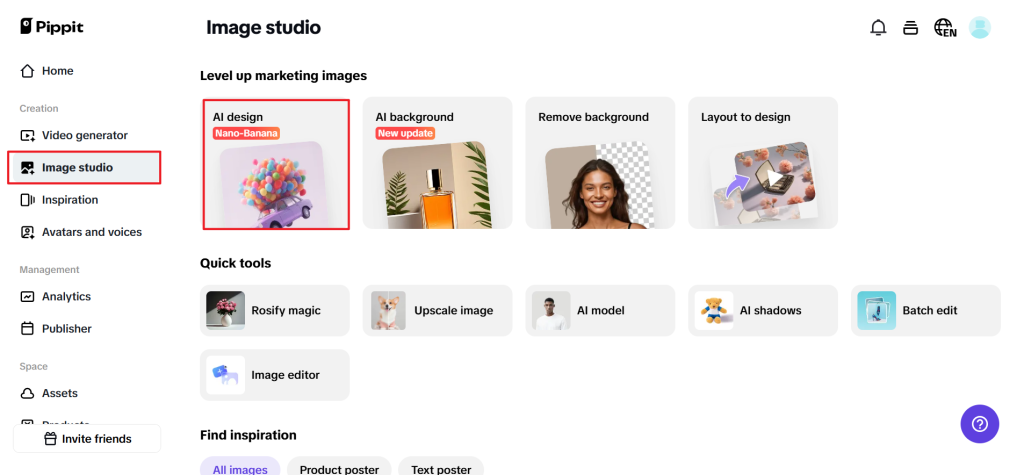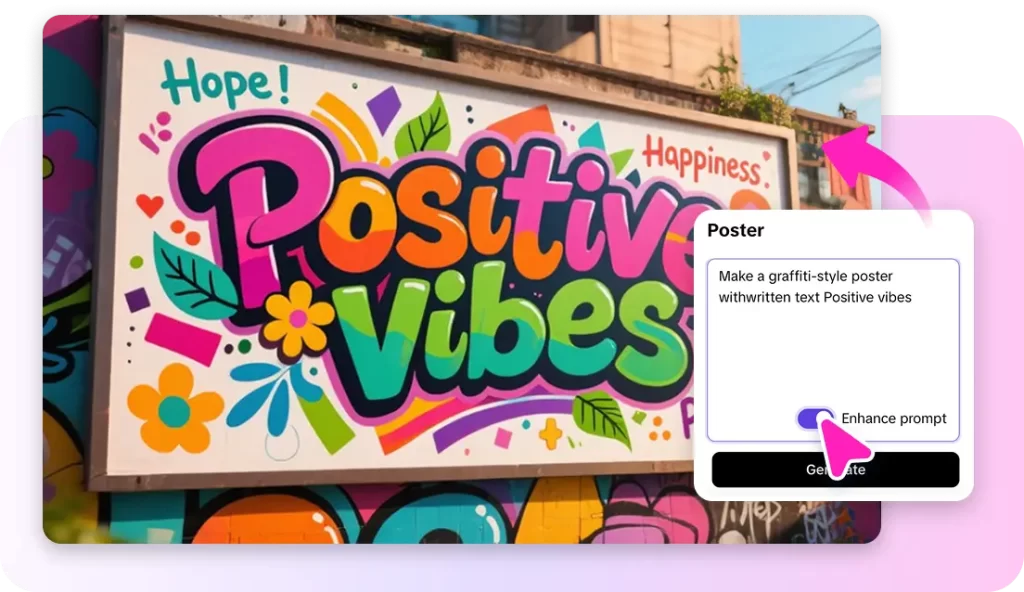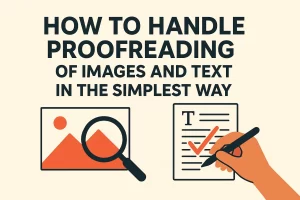Graffiti has always been a matter of movement — the fluid swoosh of paint, the rhythm of tags that expand across walls, and the pulse of color that brings concrete to life as a canvas. But now, that movement is getting a new address on the screens. In the age of TikTok loops and Instagram Reels, graffiti isn’t merely viewed — it’s animated, remixed, and made into a virtual performance.
That’s where Pippit fits right in. It has an advanced online graffiti generator feature. Creators use it to whip up graffiti-style visuals. Those are just right for dynamic video stuff. You could be a streetwear brand showing off a new drop. Or maybe an artist sharing your creative story. Even a marketer wants to make the campaign really pop. Animated graffiti adds that rebellious feel. It brings in color, too. And a bit of attitude. All straight into the scroll.

Motion as energy: why graffiti thrives in short-form videos
Graffiti is cinematic in its nature. The splatter of paint, the dissipation of texture, the action swoosh of a spray — it’s narrative in motion. Short-form videos reproduce that same energy in seconds, and so graffiti is the ideal visual language for TikTok, YouTube Shorts, and Reels.
A graffiti logo that throbs with the bass drops. A tag that comes to life as it’s being “sprayed” onto the screen. Or even a transformation timelapse where an empty wall changes into a burst of lettering and color — all these visual beats grab audiences in the first instant.
People really go for content that seems alive somehow. Graffiti has this wild rhythm that’s made just for that kind of thing. It’s not really about being perfect. It’s more like all about the energy, you know. The colors blur right into each other. Textures clash in ways that grab you. Lines move along like sound waves bouncing around. In an age where attention pretty much is currency these days, motion graffiti turns out to be pure gold.
Street art goes digital: the evolution of animated rebellion
The streets used to belong to graffiti; today, the feed does. Digital creators have made motion design a new form of tagging — one that’s virtual, shareable, and borderless. Creators now spray across pixels instead of walls, and rather than evading city guards, they pursue the algorithm.
Animated graffiti reels succeed because nostalgia and novelty are mixed. The look is recognizable — rough, defiant, and emotive — but the technique feels new. With editing software and AI, it’s now possible to animate your graffiti into fluid movements, neon trails, or distorted effects that simulate real spray physics.
It’s like bringing your tag to life — dancing, fading, bursting in time with music. Every video becomes a reflection of your style, brand, or creative voice.
Visual grit and charm: bringing graffiti to life
One of the major reasons that graffiti videos are so compelling is that they are imperfect. Grain, blur, and texture give every movement a tactile sensation — as though you can smell the paint and feel the wall. Producers frequently use Pippit’s low quality image maker to include this analog experience. They use pixelation, grain, or compression to make silky smooth animation look vintage, as though it were done on an outdated phone cam or VHS.
This method is perfect for storytelling. Visualize a graffiti tag on screen with a soft glitch, then gradually focus as lo-fi music backgrounds it. That intentional roughness makes the viewer feel something. It adds warmth to digital design — that feeling that creativity isn’t clean, and that’s precisely what makes it real.
From sketches to sequences: mapping your graffiti video flow
Story flow is important when producing graffiti-themed videos. Short videos must have rhythm, as well. Here is a straightforward creative flow that most viral graffiti reels adopt:
- Intro: Empty wall or subdued background as context.
- Reveal: Your graffiti reveals itself gradually or stroke by stroke animates.
- Impact moment: Incorporate motion bursts or camera shakes to synchronize with beats.
- End note: Utilize zoom-outs or gentle glitches to fade out with panache.
These transitions provide organization to the randomness, transforming your graffiti from a static design to a tiny story. Not only do viewers witness your artwork — they live it.
Pixel painting: creating graffiti images with Pippit
To animate your graffiti, however, first you need to design it — and with Pippit, the process feels like a virtual spray painting session. The tool assists in crafting sharp graffiti-like designs ideal for use both as static and as animations. Here’s how to begin:
Step 1: Choose “Poster” from Image studio
Click on “Image Studio” in the left sidebar of Pippit. Then choose “Poster” to begin designing your graffiti-style image. This tool allows you to create AI-designed posters that you can then animate later for Reels, TikToks, or product ads — all in the style of your brand.

Step 2: Input your idea and create
In the prompt box, explain your graffiti idea — say, “electric neon graffiti tag in 3D effect, splattered paint style, dark city wall background.” Activate “Enhance prompt” to make your output more detailed. Select the “graffiti” style under creative posters, and then click “Generate.” Pippit will generate several graffiti images, each full of color and street vibe.

Step 3: Choose, refine, and finalize your design
Check over the AI results and choose one that suits your video idea. Click your chosen poster to bring up the editor — here, you can adjust colors, add a background, or place your logo on top. When prepared, click “Download.” Your graffiti piece is now ready to be animated in your chosen video editor.

Bringing graffiti to life: easy animation hacks for viral loops
When your graffiti is complete, the best part — bringing it to life. Even basic animations will enhance your graffiti enormously:
- Reveal effects: Treat your graffiti as if it is being “sprayed” live. Employ masking or drawing tools to simulate paint movement on a wall.
- Pulse and beat-sync: Get your graffiti logo to pulse over the music. Great for companies employing high-tempo songs or hip-hop beats.
- Drip and fade: Add drips or fade-outs of paint for organic texture. It gives that feeling of satisfaction of completion.
- Color transitions: Experiment with changing color palettes halfway through the animation — from grunge to glow, or monochrome to neon.
Every little gesture brings graffiti to life, making static imagery dramatic storytelling points.
The psychology of graffiti motion: chaos meets connection
Graffiti animation is effective because it spans disorder with order. It invites the eye with messiness — bursts of spray, jagged edges, dancing textures — but maintains focus with rhythm and shape. This tension reflects how individuals engage online: the scroll is messy, but the pause occurs when something goes differently.
Motion graffiti does just that. It breaks pattern fatigue on social media streams, reminding the viewer that imperfection is beauty. The flashes of color, the rhythmic cuts, the tactile roughness — all reach out and connect on an emotional level.
As a brand, that’s a superpower. It means you can express rebellion, creativity, and authenticity in a few seconds of visual motion.
Pippit: from street walls to scroll feeds
Digital graffiti isn’t supplanting traditional art — it’s reimagining it. Artists who previously tagged up buildings are now tagging up algorithms, and brands that previously worried about rebellion are now embracing it as a strategy.
Pippit empowers creators and businesses with the spray can of the future. With its AI-driven online graffiti generator, you can create urban-style visuals that throb with identity — then bring them to life in videos that halt the scroll.
Whether it’s launching a campaign, selling merch, or simply adding fuel to your Reels, Pippit enables you to bring the essence of graffiti — bold, emotive, and vibrant.
Begin developing your animated graffiti graphics with Pippit today — and bring your art to life that inspires action!




